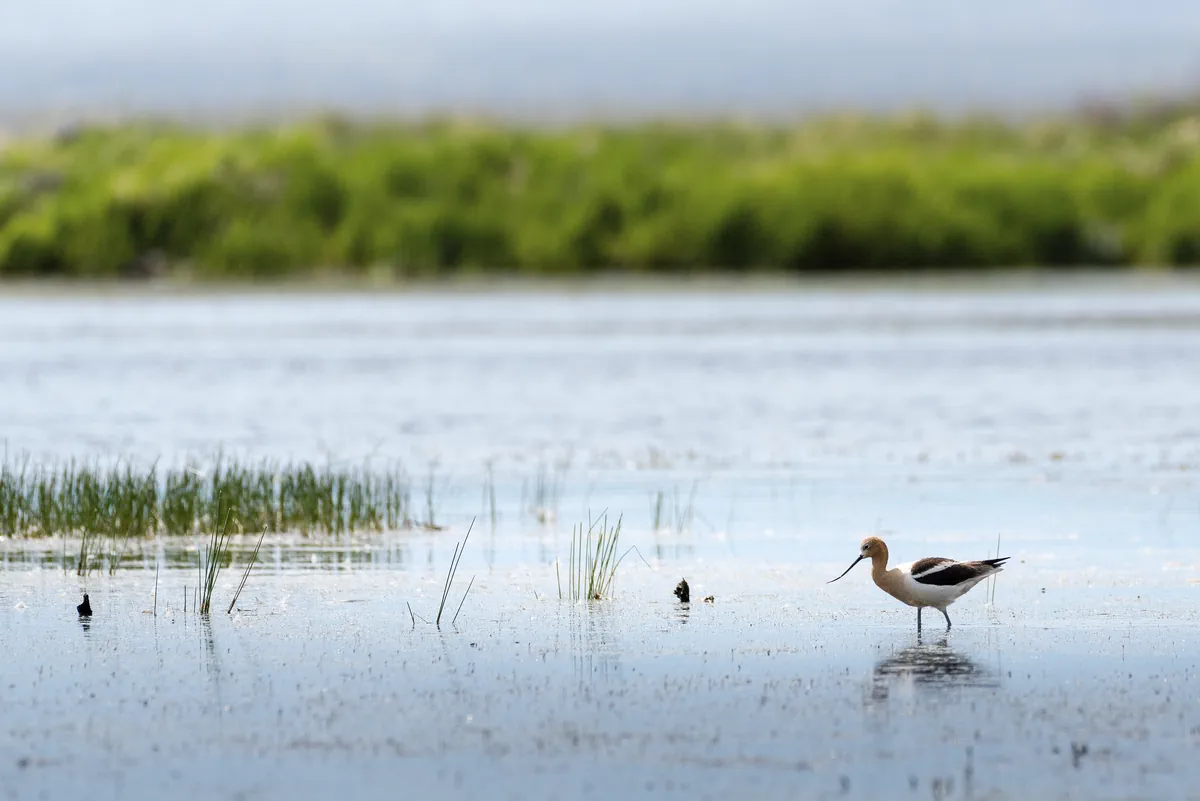Back in 2018, I was roaming the Arapaho Wilderness in northern Colorado near Walden when I came upon a sight that instantly took me back to a childhood memory. Years earlier, I had visited a zoo where a large open area housed a mated pair of American Avocets — birds that could no longer survive in the wild but captivated children and adults alike, myself included. That day at the zoo was the first time I had ever seen an avocet. I remember being struck by their remarkable appearance and quiet intelligence. Their long stilt-like legs moved them gracefully through the water as they swept their heads side to side, bills slicing just below the surface.
Fast forward to that day in 2018: there I was again, this time deep in the high country, camera in hand and a 500 mm lens ready, watching a wild avocet glide across a shallow meltwater lake at sundown. Its mate wasn’t far from the shoreline of this seasonal pool, formed by snowmelt from the Rockies towering above. I have to tell you — I was in awe. I never thought I’d see this bird in the wild. When I first met the species in captivity, it felt like something exotic and distant, a creature from another part of the world, not one I’d stumble upon on the high plains of the Rockies’ western slope.
In 2019, life took me east. I moved from northern Colorado to western Nebraska, about twenty miles from the Wyoming state line. My new town was fortunate to have the North Platte River running straight through its heart, with only a single bridge connecting two small sister cities. One evening I was driving a dirt road upstream, where the river meanders through wild stretches of private land few people can access. Out of the corner of my eye, I caught sight of something moving along the shallows — then another. To my astonishment, I was looking at two pairs of American Avocets. Here? In western Nebraska? I had left the mountains behind; surely these birds belonged on the alpine wetlands of Colorado, not on the plains.
I didn’t have my camera, so I raced home and came back just before sunset. The birds were still there, wading the shallows as if they owned them, probing for food and perhaps scouting a place to settle for the night — maybe even to nest. I spent nearly an hour watching and filming them until the sun slid below the horizon and the river glowed with evening light.
That encounter changed something for me. I wanted to know more about these elegant travelers. What I learned was far beyond fascinating — it was remarkable. The American Avocet is a bird North America sees every year, a resilient migrant that overcomes staggering challenges to make it to places like the Platte River, the Great Plains, and beyond.
The American Avocet: A Sentinel of Shallow Water
The American Avocet (Recurvirostra americana) is one of those birds that doesn’t sneak into a wetland; it arrives with grace and purpose — stilt-legged, black-and-white wings flashing, its elegant upturned bill slicing through the shallows. It’s a bird built for margins where land surrenders to water. When avocets thrive, wetlands are healthy. When they vanish, the system is failing.
Form and Function
Avocets stand tall on bluish-gray legs, their slender bodies poised just above the water. Their long, thin bills curve upward, a precision tool designed for sweeping side to side just under the surface to catch tiny aquatic creatures. In summer, their head and neck glow with a warm cinnamon hue that fades to pale gray in winter, but the crisp black-and-white wings remain a bold signal on the open flats. This combination of long reach, sensitivity, and specialized feeding technique makes them superb hunters in shallow water.
A Life on the Edge
These birds thrive in transition zones: prairie potholes, saline lakes, flooded playas, and alkaline flats across the Great Plains and interior West. They avoid dense reeds and prefer open, gently sloped shallows where they can spot predators early. Nesting sites are simple scrapes on bare ground near water, sometimes on isolated islands or man-made levees that provide safety. After breeding, avocets move to coastal lagoons and tidal flats from California and the Gulf Coast to Mexico, following food and favorable water levels.
Wetlands that support avocets do far more than shelter birds. They filter water, trap sediments, absorb floods, and feed entire food webs — from plankton to fish to larger birds. An avocet’s presence signals that these systems are intact and functioning.
Daily Habits and Behavior
Avocets are deliberate, efficient feeders. They walk slowly, sweeping their bills rhythmically from side to side just below the water’s surface to stir up aquatic insects, crustaceans, and brine shrimp. They often forage in loose groups, spacing themselves just far enough apart to avoid competition while taking advantage of the same productive shallows. Social by nature, they sound sharp alarm calls when danger approaches and sometimes dive at intruders to distract or drive them off. This cooperative vigilance is critical in the open, exposed habitats they prefer.
Seasons and Migration
Life for an avocet is tuned to water and season. Spring thaw floods prairies and playas, bringing insect hatches that fuel breeding. Birds arrive in pairs or loose groups, scrape shallow nests, and line them with plant material or feathers. Chicks hatch covered in down and leave the nest within hours, able to feed themselves while parents stand guard.
By late summer, avocets disperse to coastal bays and estuaries. On the Pacific Coast, places like San Francisco Bay’s restored salt ponds provide ideal foraging and safe roosting. In winter, avocets gather in impressive flocks on tidal mudflats, where they find stable food supplies and mild climates.
The species is also a long-distance migrant. Avocets breeding in the interior West and northern Great Plains head south for the cold months, following river valleys, wetlands, and reservoirs as rest stops. The North Platte River, where I saw those birds, is one such corridor. It’s not a fluke to see them there — these rivers and connected wetlands become vital highways during migration, especially in late summer and early fall when birds refuel before pushing on to the Gulf Coast, Mexico, or California’s coastal lagoons.
Pressures on the Avocet
Life on the edge of water comes with vulnerability. Several human-driven and climate-related threats challenge avocet survival:
Wetland loss and water diversion. Draining prairie potholes, pumping playas dry, or redirecting natural flows to irrigation and cities destroys the shallow-water habitat avocets depend on. In the arid West, shrinking saline lakes and dried lakebeds eliminate food and shelter while releasing dust harmful to both wildlife and people.
Agricultural chemicals. Pesticides and fertilizers change the wetland food web. Insects decline, water quality deteriorates, and the very prey avocets need to raise chicks disappears. Their feeding style — skimming surface layers — exposes them directly to contaminants.
Human disturbance. Avocets nest openly on bare ground, often near roads, levees, and shorelines. Off-leash dogs, ATVs, photographers, and drones can flush parents from nests, leaving eggs and chicks vulnerable to heat, cold, or predators. A few hours of repeated disturbance can wipe out a colony.
Predator imbalance. Fragmented habitats encourage adaptable predators like raccoons and crows. Without safe islands or predator control, ground nests are easily raided.
Climate change. Longer droughts, higher temperatures, and erratic precipitation dry shallow wetlands and shift insect emergence. If chicks hatch after the main insect bloom, they face food shortages. Along coasts, rising seas squeeze tidal flats between water and hard infrastructure, reducing winter habitat.
Why the Avocet Matters
Avocets aren’t just beautiful; they’re ecological sentinels. Because they rely on shallow wetlands rich in invertebrates, their presence — or absence — quickly signals changes in water quality, salinity, and food availability. Their wetlands also deliver vital services to people: cleaner water, reduced flooding, and carbon storage. Protecting avocet habitat supports fish nurseries, waterfowl, and countless other creatures. Economically, avocets and their wetlands attract birders, photographers, and eco-tourists, supporting local economies and giving communities a stake in conservation.
Conservation That Works
Avocets respond well to practical, science-driven management:
- Wetland restoration. Rehabilitating salt ponds, reconnecting tidal marshes, and maintaining seasonal shallow water has led to immediate rebounds in avocet numbers.
- Protecting water flows. Allocating modest water rights to keep wetlands alive during drought is essential. Incentives for landowners to flood fields post-harvest along migration corridors create important stopover sites.
- Island creation. Low, sparsely vegetated islands reduce predation and disturbance when water levels are managed with breeding cycles in mind.
- Disturbance management. Seasonal closures, leash laws, and clear signage protect nesting colonies. Respectful viewing from a distance lets birds breed successfully while still providing recreational value.
- Cleaner runoff. Farm practices like vegetated buffers, reduced pesticide use, and smarter irrigation keep chemicals out of wetlands, protecting the insect base avocets need.
Population Outlook
The American Avocet is not officially endangered, but “common” doesn’t mean secure. Its wide range can mask local collapses, and its dependence on increasingly scarce shallow wetlands puts it at risk. Long-term surveys show clear declines where water is diverted, pollution is unchecked, and restoration is absent. Conversely, where wetlands are managed with intentional water levels, predator control, and limited disturbance, avocets rebound. They’re resilient if given the right conditions.
The avocet’s needs are simple: ankle-deep water teeming with life, safe nesting sites, and protection during the breeding season. Meeting those needs doesn’t require reinventing conservation; it requires commitment and practical water and land management. Flood a harvested field to mimic a playa, maintain salinity levels in a retired salt pond, and keep dogs off nesting islands — and avocets will reward the effort with thriving colonies.
For land managers and policy makers, the avocet is a bird that bridges ecological health and human benefit. Wetlands that sustain avocets also recharge aquifers, blunt storms, and keep fisheries alive. Supporting avocets means supporting systems people rely on.
Why They Deserve Attention
Avocets don’t hide. They stand visible against open water, a real-time indicator of how well we’re caring for our wetlands. They embody the connection between water policy, agricultural practices, coastal resilience, and wildlife health. Lose them, and it’s a warning we’re ignoring the foundation of our water landscapes.
This is a bird of elegant design and practical purpose: a sentinel in cinnamon and white, sweeping its bill through the shallows, raising the next generation on mudflats and saline lakes. Protect the water, hold space for wetlands, and the avocet will keep its watch — not just for itself, but for the countless species and people tied to these living edges.
References and research
- Cornell Lab of Ornithology – American Avocet Overview
- National Audubon Society – American Avocet Field Guide
- U.S. Fish & Wildlife Service – Species Profile: American Avocet
- American Bird Conservancy – American Avocet
- National Park Service – American Avocet Natural History
- USGS Patuxent Wildlife Research Center – American Avocet Studies
- San Francisco Bay Bird Observatory – Avocets & Salt Pond Restoration
- Audubon – Climate Vulnerability of the American Avocet
- BirdLife International – American Avocet Species Factsheet
- State of the Birds Report – Shorebird Population Trends





